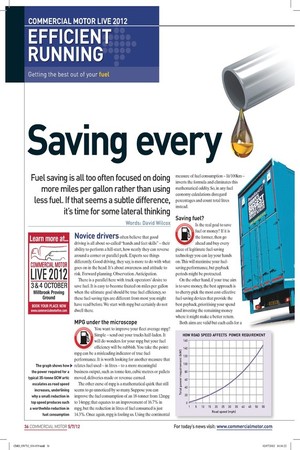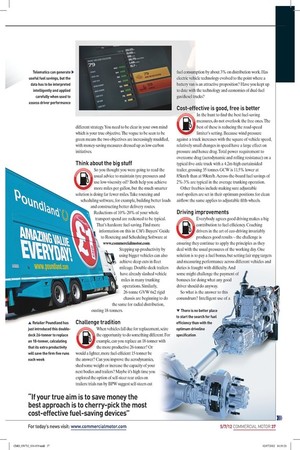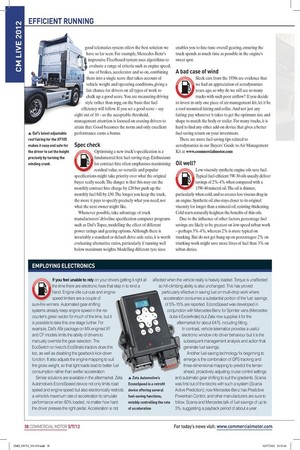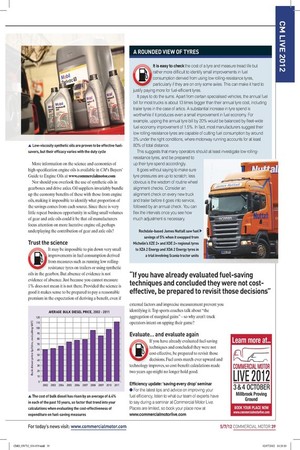Saving every
Page 27

Page 28

Page 29

Page 30

If you've noticed an error in this article please click here to report it so we can fix it.
Fuel saving is all too often focused on doing more miles per gallon rather than using less fuel. If that seems a subtle difference, it’s time for some lateral thinking
Words: David Wilcox Novice drivers often believe that good driving is all about so-called “hands and feet skills” – their ability to perform a hill-start, how neatly they can reverse around a corner or parallel park. Experts see things differently. Good driving, they say, is more to do with what goes on in the head. It’s about awareness and attitude to risk. Forward planning. Observation. Anticipation.
There is a parallel here with truck operators’ desire to save fuel. It is easy to become fixated on miles per gallon when the ultimate goal should be true fuel efficiency, so these fuel-saving tips are different from most you might have read before. We start with mpg but certainly do not dwell there.
MPG under the microscope
You want to improve your fleet average mpg? Simple – send out your trucks half-laden. It will do wonders for your mpg but your fuel efficiency will be rubbish. You take the point: mpg can be a misleading indicator of true fuel performance. It is worth looking for another measure that relates fuel used – in litres – to a more meaningful business output, such as tonne-km, cubic metres or pallets moved, deliveries made or revenue earned.
The other curse of mpg is a mathematical quirk that still seems to go unnoticed by so many. Suppose you can improve the fuel consumption of an 18-tonner from 12mpg to 14mpg; that equates to an improvement of 16.7% in mpg, but the reduction in litres of fuel consumed is just 14.3%. Once again, mpg is fooling us. Using the continental measure of fuel consumption – lit/100km – inverts the formula and eliminates this mathematical oddity. So, in any fuel economy calculations disregard percentages and count total litres instead.
Saving fuel?
Is the real goal to save fuel or money? If it is the former, then go ahead and buy every piece of legitimate fuel-saving technology you can lay your hands on. This will maximise your fuelsaving performance, but payback periods might be protracted.
On the other hand, if your true aim is to save money, the best approach is to cherry-pick the most cost-effective fuel-saving devices that provide the best payback, prioritising your spend and investing the remaining money where it might make a better return.
Both aims are valid but each calls for a different strategy. You need to be clear in your own mind which is your true objective. The vogue to be seen to be green means the two objectives are increasingly muddled, with money-saving measures dressed up as low-carbon initiatives.
Think about the big stuff
So you thought you were going to read the usual advice to maintain tyre pressures and use low-viscosity oil? Both help you achieve more miles per gallon, but the much smarter solution is doing far fewer miles. Take routeing and scheduling software, for example, building better loads and constructing better delivery routes. Reductions of 10%-20% of your whole transport spend are reckoned to be typical. That’s hardcore fuel-saving. Find more information on this in CM’s Buyers’ Guide to Routeing and Scheduling Software at www.commercialmotor.com.
Stepping up productivity by using bigger vehicles can also achieve deep cuts in fleet mileage. Double-deck trailers have already slashed vehicle miles in many trunking operations. Similarly, 26-tonne GVW 6x2 rigid chassis are beginning to do the same for radial distribution, ousting 18-tonners.
Challenge tradition
When vehicles fall due for replacement, seize the opportunity to do something different. For example, can you replace an 18-tonner with the more productive 26-tonner? Or would a lighter, more fuel-efficient 15-tonner be the answer? Can you improve the aerodynamics, shed some weight or increase the capacity of your next bodies and trailers? Maybe it’s high time you explored the option of self-steer rear axles on trailers: trials run by BPW suggest self-steers cut fuel consumption by about 3% on distribution work. Has electric vehicle technology evolved to the point where a battery van is an attractive proposition? Have you kept up to date with the technology and economics of dual-fuel gas/diesel trucks?
Cost-effective is good, free is better
In the hunt to find the best fuel-saving measures, do not overlook the free ones. The best of these is reducing the road-speed limiter’s setting. Because wind pressure against a truck increases with the square of vehicle speed, relatively small changes in speed have a large effect on pressure and hence drag. Total power requirement to overcome drag (aerodynamic and rolling resistance) on a typical five-axle truck with a 4.2m-high curtainsided trailer, grossing 35 tonnes GCW is 11.5% lower at 85km/h than at 90km/h. Across-the-board fuel savings of 2%-3% are typical in the average trunking operation.
Other freebies include making sure adjustable roof-spoilers are set in their optimum positions for clean airflow: the same applies to adjustable fifth-wheels.
Driving improvements
Everybody agrees good driving makes a big contribution to fuel efficiency. Coaching drivers in the art of eco-driving invariably produces good results – the challenge is ensuring they continue to apply the principles as they deal with the usual pressures of the working day. One solution is to pay a fuel bonus, but setting fair mpg targets and measuring performance across different vehicles and duties is fraught with difficulty. And some might challenge the payment of bonuses for doing what any good driver should do anyway.
So what is the answer to this conundrum? Intelligent use of a good telematics system offers the best solution we have so far seen. For example, Mercedes-Benz’s impressive Fleetboard system uses algorithms to evaluate a range of criteria such as engine speed, use of brakes, accelerator and so on, combining them into a single score that takes account of vehicle weight and operating conditions, giving a fair chance for drivers on all types of work to chalk up a good score. You are measuring driving style rather than mpg, on the basis that fuel efficiency will follow. If you set a good score – say eight out of 10 – as the acceptable threshold, management attention is focused on coaxing drivers to attain that. Good becomes the norm and only excellent performance earns a bonus.
Spec check
Optimising a new truck’s specification is a fundamental first fuel-saving step. Enthusiasm for contract hire often emphasises maximising residual value, so versatile and popular specifications might take priority over what the original buyer really needs. The danger is that this may cut the monthly contract hire charge by £20 but push up the monthly fuel bill by £50. The longer you keep the truck, the more it pays to specify precisely what you need, not what the next owner might like.
Whenever possible, take advantage of truck manufacturers’ driveline specification computer programs such as Daf’s Topec, modelling the effect of different power ratings and gearing options. Although there is invariably a standard or default drive-axle ratio, it is worth evaluating alternative ratios, particularly if running well below maximum weights. Modelling different tyre sizes enables you to fine-tune overall gearing, ensuring the truck spends as much time as possible in the engine’s sweet spot.
A bad case of wind
Sleek cars from the 1930s are evidence that we had an appreciation of aerodynamics years ago, so why do we still see so many trucks with such poor airflow? If you decide to invest in only one piece of air-management kit, let it be a roof-mounted fairing and collar. And not just any fairing: pay whatever it takes to get the optimum size and shape to match the body or trailer. For many trucks, it is hard to find any other add-on device that gives a better fuel-saving return on your investment.
There are more fuel-saving tips related to aerodynamics in our Buyers’ Guide to Air Management Kit at www.commercialmotor.com
Oil well?
Low-viscosity synthetic engine oils save fuel. Typical fuel-efficient 5W-30 oils usually deliver savings of 2%-4% when compared with a 15W-40 mineral oil. The oil is thinner, particularly when cold, and so creates less viscous drag in an engine. Synthetic oil also stays closer to its original viscosity for longer than a mineral oil, resisting thickening. Cold starts naturally heighten the benefits of thin oils.
Due to the influence of other factors, percentage fuel savings are likely to be greatest on low-speed urban work – perhaps 3%-4%, whereas 2% is more typical on trunking. But do not get hung up on percentages: 2% on trunking work might save more litres of fuel than 3% on urban duties. More information on the science and economics of high-specification engine oils is available in CM’s Buyers’ Guide to Engine Oils at www.commercialmotor.com Nor should you overlook the use of synthetic oils in gearboxes and drive axles. Oil suppliers invariably bundle up the economy benefits of these with those from engine oils, making it impossible to identify what proportion of the savings comes from each source. Since there is very little repeat business opportunity in selling small volumes of gear and axle oils could it be that oil manufacturers focus attention on more lucrative engine oil, perhaps underplaying the contribution of gear and axle oils?
Trust the science
It may be impossible to pin down very small improvements in fuel consumption derived from measures such as running low rollingresistance tyres on trailers or using synthetic oils in the gearbox. But absence of evidence is not evidence of absence. Just because you cannot measure 1% does not mean it is not there. Provided the science is good it makes sense to be prepared to pay a reasonable premium in the expectation of deriving a benefit, even if external factors and imprecise measurement prevent you identifying it. Top sports coaches talk about “the aggregation of marginal gains” – so why aren’t truck operators intent on upping their game?
Evaluate... and evaluate again
If you have already evaluated fuel-saving techniques and concluded they were not cost-effective, be prepared to revisit those decisions. Fuel costs march ever upward and technology improves, so cost-benefit calculations made two years ago might no longer hold good.
Efficiency update: ‘saving every drop’ seminar l For the latest tips and advice on improving your fuel efficiency, listen to what our team of experts have to say during a seminar at Commercial Motor Live. Places are limited, so book your place now at www.commercialmotorlive.com
EMPLOYING ELECTRONICS
If you feel unable to rely on your drivers getting it right all the time there are electronic fixes that step in to lend a hand. Engine-idle cut-outs and engine speed limiters are a couple of sure-fire winners. Automated gear-shifting systems already keep engine speed in the rev counter’s green sector for much of the time, but it is possible to take this one stage further. For example, Daf’s ATe package on MX-engined XF and CF models limits the ability of drivers to manually override the gear selection. The EcoSwitch on Iveco’s EcoStralis tractors does this too, as well as disabling the gearbox’s kick-down function. It also adjusts the engine mapping to suit the gross weight, so that light loads lead to better fuel consumption rather than swifter acceleration. Similar solutions are available in the aftermarket. Zeta Automotive’s EconoSpeed device not only limits road speed and engine speed but also electronically restricts a vehicle’s maximum rate of acceleration to simulate performance when 60% loaded, no matter how hard the driver presses the right pedal. Acceleration is not affected when the vehicle really is heavily loaded. Torque is unaffected so hill-climbing ability is also unchanged. This has proved particularly effective in saving fuel on multi-drop work where acceleration consumes a substantial portion of the fuel: savings of 5%-15% are reported. EconoSpeed was developed in conjunction with Mercedes-Benz for Sprinter vans (Mercedes dubs it ExcelArate) but Zeta now supplies it for the aftermarket for about £475, including fitting.
In contrast, vehicle telematics provides a useful electronic window into driver behaviour but it is the subsequent management analysis and action that generate fuel savings.
Another fuel-saving technology fix beginning to emerge is the combination of GPS tracking and three-dimensional mapping to predict the terrain ahead, proactively adjusting cruise control settings and automatic gear shifting to suit the gradients. Scania was first out of the blocks with such a system (Scania Active Prediction); now Mercedes-Benz has Predictive Powertrain Control, and other manufacturers are sure to follow. Scania and Mercedes talk of fuel savings of up to 3%, suggesting a payback period of about a year.
A ROUNDED VIEW OF TYRES
ft is easy to check the cost of a tyre and measure tread life but rather more difficult to identify small improvements in fuel consumption derived from using low rolling-resistance tyres, particularly if they are on only some axles. This can make it hard to justify paying more for fuel-efficient tyres.
It pays to do the sums. Apart from certain specialised vehicles, the annual fuel bill for most trucks is about 13 times bigger than their annual tyre cost, including trailer tyres in the case of artics. A substantial increase in tyre spend is worthwhile if it produces even a small improvement in fuel economy. For example, upping the annual tyre bill by 20% would be balanced by fleet-wide fuel economy improvement of 1.5%. In fact, most manufacturers suggest their low rolling-resistance tyres are capable of cutting fuel consumption by around 3% under the right conditions, where motorway running accounts for at least 80% of total distance.
This suggests that many operators should at least investigate low rolling resistance tyres, and be prepared to up their tyre spend accordingly.
It goes without saying to make sure tyre pressures are up to scratch; less obvious is the wisdom of routine wheel alignment checks. Consider an alignment check on every new truck and trailer before it goes into service, followed by an annual check. You can flex the intervals once you see how much adjustment is necessary.
Rochdale-based James Nuttall saw fuel savings of 5% when it swapped from Michelin’s XZE 2+ and XDE 2+ regional tyres to XZA 2 Energy and XDA 2 Energy tyres in a trial involving Scania tractor units










































